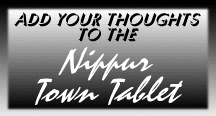Inscribed Door-Socket of King Shar-kali-sharri
Here is a hand drawn copy of the cuneiform inscription on the stone door socket (German: T�rangelstein; French: crapaudine) found by John Peters near the ziggurat at Nippur. For his description of door-sockets see Door-sockets: weighty inscriptions in the temple. A second door-socket was also found. The two inscribed stone blocks originally flanked the main entrance to the Enlil temple constructed by King Shar-kali-sharri (2217-2193 B.C.). The work was actually begun, but not finished, by his father, King Naram-Sin (2254-2218). The ziggurat itself was not built until later by Ur-Nammu (2112-2095 B.C.). You can view a plan of the ziggurat area at our page on the Small Shrine for Enlil. To study the inscription from the photograph, take a look at the photograph of Shar-kali-sharri's door socket.
 This inscription of Shar-kali-sharri, king of Akkad, is written in Akkadian with some Sumerian words as logograms (word-signs). It can be read as follows, with commas separating each line or case.
This inscription of Shar-kali-sharri, king of Akkad, is written in Akkadian with some Sumerian words as logograms (word-signs). It can be read as follows, with commas separating each line or case.
Column One: den-l�l, u-k�l-lim, ?ar-k�-l�-?�r-r�, da-n�m, LUGAL, a-ga-d�ki, baD�M, �-kur, �, den-l�l, in nibruki, ?a DUB.
This column (excluding the last line) can be translated: Enlil revealed (that is, gave approval and instruction by divinatory sign). Shar-kali-sharri, the Mighty, the King of Agade, the Builder of Ekur, Enlil's temple in Nippur.
Column Two: ?ux(SU)-a, u-?a-s�-ku-ni, den-l�l, �, dutu, �, dinanna, SUHU?-?u, li-s�-hu, �, ?E.NUMUN-?u, li-il-q�-tu.
This column (beginning with the last line of column one) can be translated: Whoever removes this inscription, may Enlil, Utu and Inanna tear out his foundation and destroy his progeny.
A few notes on cuneiform writing
- The divine names in the inscription are preceded by a star or asterisk looking character, the determinative (word classifier) d, short for dingir "god/deity." Shar-kali-sharri mentions the deities Enlil (Nippur's main god, for whose temple the king sponsored construction work), Utu (sun god, guarantor of justice), and Inanna (goddess of love/war, main deity of Agade).
- Place names are followed by the determinative for place ki, occurring here after the name of Nibru (that is, Nippur). Can you see what symbols are used to write the city name? Hint: compare lines 1 and 11 of column 1.
- The character ? is pronounced as our sound "sh."
- The Akkadian long vowels would be better represented with the macron, but the standard lists of entities for web browsers do not include vowels with macrons.
Cuneiform vocabulary here
- Akkadian documents through many centuries mixed together word signs in Sumerian with the Akkadian words spelled out. Notice the word signs for LUGAL, Akkadian ?arrum, "king," baD�M, Akkadian b�n�, "builder," and �, Akkadian b�t, "house/temple of," DUB, Akkadian tuppam, "inscription/tablet," SUHU?, Akkadian i?d�, "foundation," and ?E.NUMUN, Akkadian zera, "progeny/seed."
- Akkadian vocabulary used here include kullumu "reveal/show," dannum "mighty/strong," nas�ku Stem III "remove/eliminate," nas�hu "tear out/uproot," laq�tu "destroy" (Akkadische Handw�rterbuch offers "zur Vernichtung einsammeln, wegraffen").
This hand copy of the inscription is taken from H.V. Hilprecht, Old Babylonian Inscriptions Chiefly from Nippur: The Babylonian Expedition of the University of Pennsylvania, Series A, Cuneiform Texts, Philadelphia, 1893, Volume I, Part I, Text No. 1.
Click on these links to navigate our site:
- Return to the Royal Display Room.
- To see Nippur through the eyes of explorer and excavator John Punnett Peters, first modern archaeologist at Nippur, visit our Earth-Moving Room.
- To help visualize the layout of Nippur and its environs, visit the Map Room.
- To learn more about ancient Nippur, discover the resources in the Reading Room, or study the bigger picture of cuneiform culture at the Reading Room's Cultural Annex.
- To get an overview of Nippur, go to the Broad Vista Room.
- To evaluate the specialization of labor and professionalism at ancient Nippur, take a look in the Professional Room.
- To learn about the non-human inhabitants of Nippur and its neighbors, visit Anshe's Tablet Room or his Lessons from Old Bones.
- To sneak up for a close look at "the establishment," step into the Establishment Room.
- After you have wandered through the rooms of Dubsar's abode, try your hand at the Nippur Quiz. JavaScript required. Two levels now available.
- Return to the home page of Dubsar, the Cuneiform Scribe.



This page was edited on 31 December 2000. If you have cuneiform questions or comments, please email Dubsar, the Cuneiform Scribe. If I do not respond promptly, the vendor supplying Fortune City's email service may be eating your mail for lunch. In that case, you can give a shout over to Dubsar's Sand Dune to get my attention. Thanks! � 1998-1999 Erasmus Compositor, P.O. Box 25958, Baltimore, MD 21224.

